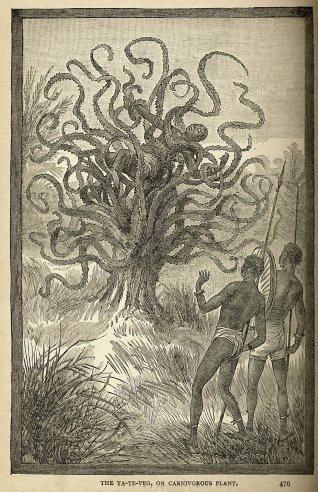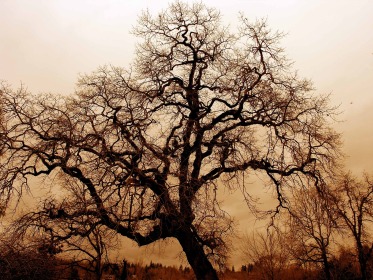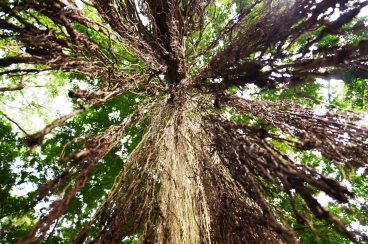I love the outdoors. I love camping, hiking, and walking around without a flashlight at night while trying to guess the shape of the shadows next to me. But whenever I sleep under the stars, there’s a small part of my brain that remains wide awake, watchful of anything that might approach. I always feel safer under the cover of trees. But maybe the trees are what I should be afraid of.
In honor of this month’s Supermoon, let’s do something a little different. Instead of focusing on one specific type of monster plant, I want to give you an idea of the range and themes of what’s out there. Though the plants can be found all over the world, some have a number of similarities. This list will focus largely on the ones with human (or potential human) victims, because you’re visiting a monster blog, and things wouldn’t be as fun without the potential for death or dismemberment.
Like true botanists, let’s categorize our plants into groups:
1. Stranglers
These are the most basic of the three types. Many monster plants seem to employ at least some degree of physical grabbing or binding to keep their prey still while they work on them; pure stranglers just squeeze and squeeze until their victim has breathed their last, then drop the corpse and soak up the blood and nutrients therein.
One good example of a Strangler is the Brazilian Devil Tree. It’s said to camouflage its branches in nearby foliage until its prey gets close enough to grab, then snaps out, wrapping quickly around the victim’s torso and throat, and tightens, boa-constrictor-style, until the victim is dead.
Then there’s the account of a planter from Mississippi who visited the Filipino region of Mindanao cerca 1925. The man and his guide came upon a large, gray tree surrounded by bones and the smell of rotting meat. The Mississippian noticed a human skull among those bones, and started to approach it before his guide called out in warning. He then looked up to find the tree leaning toward him, gracefully, confidently, branches swaying like cobras on the approach. Mesmerized, the man stood completely still. One branch got as close as the his eyebrow–close enough that he could see the spines along its leaves and smell the stench of carrion that emanated from it–before his guide pulled him back out of reach. The tree grasped for them still, straining, as they turned heel and fled.
2. Vampires
Undead hotties and mosquitoes aren’t the only ones who can suck a little blood. Some say plants can thirst for it desperately, be it from a rat, dog, or human.

The Yateveo, courtesy of Wikimedia Commons
One of the most famous vampire plants is the Yate-veo of Central America (thanks to my bachelor’s degree, I can share that “ya te veo” means roughly “I can already see you.” Charming, right?). Like the Brazilian Devil tree, this monstrous plant hides its weapons–this time long needles lined with spikes–under leaves or even underground. Then when an animal (or human) walks by, the Yate-veo snaps up to impale them. The needles draw the victim’s blood up into the branches; presumably if he doesn’t get away quickly, he can be bled out where he stands.
Another account comes from naturalist Mr. Dunstan, who sought to gather plant specimens in Nicaragua some time ago (no word on the exact date…most of these stories take place in the late 1800’s or early 1900’s, so let’s call it 1900 even). Dunstan was wading through a swamp with his dog and a team of helpers when he lost sight of the former and heard him start to whine and yelp. He turned back to find his poor canine trapped in a nest of black vines, all covered in a sticky, malodorous pus that seemed to ooze from the plant itself. Dunstan and his men tried to cut the dog away, but quickly found the vines wrapping around their own arms and hands, leaving blisters and burns wherever they went. Once the plant had latched on, it was nearly impossible to remove without also tearing off your skin.
The team did manage to get the dog out, but barely–the little guy could hardly walk, and was super disoriented. Dunstan, being a crazy plant person, went back later to try and study their attacker (locals informed him it was called the Devil’s Snare), but given the nature of the beast, it proved difficult to get very close. Here’s what he did find:
“The plant’s power of suction is contained within a number of infinitesimal mouths or little suckers, which, ordinarily closed, open for the reception of food. If the substance is animal, the blood is drawn off and the carcass or refuse then dropped. A lump of raw meat being thrown to it, in the short space of five minutes the blood will be thoroughly drunk off and the mass thrown aside. Its voracity is almost beyond belief.”
Needless to stay, Dunstan didn’t stick around much longer after that.
3. Druggers

Generic scary tree image from Pixabay!
Our final group is possibly the most frightening one. These are the plants that lull their victims to sleep, stupor, or madness before devouring their unresisting bodies alive. The earliest tale of this type comes the 1500’s, when an explorer in the South Pacific reported a ginormous flower that exuded pheromones to make anyone who came around it very sleepy. Like idiots, its victims would purportedly lie down on the plant’s soft petals, whereupon the flower would close and digest them while they slept.
The other example of a Drugger plant is probably one of the most famous monster plant stories around. In 1874, German explorer Karl Liche reported a sort of giant Malagasy pineapple that people would supposedly sacrifice women to. The victims would be forced to drink its sap, which would both drug them and drive them insane. Here’s Liche’s description:
“The slender delicate palpi, with the fury of starved serpents, quivered a moment over her head, then as if instinct with demoniac intelligence fastened upon her in sudden coils round and round her neck and arms; then while her awful screams and yet more awful laughter rose wildly to be instantly strangled down again into a gurgling moan, the tendrils one after another, like great green serpents, with brutal energy and infernal rapidity, rose, retracted themselves, and wrapped her about in fold after fold, ever tightening with cruel swiftness and savage tenacity of anacondas fastening upon their prey.”
Of course, Liche’s account was called into question for being so shamelessly sensationalist. Most scholars now believe that the explorer didn’t even exist–that a journalist made both him and the (rather xenophobic) story up (though, in an interesting plot twist, there may be no evidence that journalist existed either). Still, people kept up the search for that killer pineapple for a few generations. Later expeditions revealed either everyone knowing about the plant but no one having seen it, or (later) no one having heard of the plant, but knowing instead about another carnivorous plant, this time one that exudes poisonous gas. So the world turns ‘round.
***
How much stock should we put in these stories? If you’ve been paying attention, you’ll notice the common thread of white explorers being freaked out by foreign flora and/or telling wild tales that exoticize their experiences abroad and make them look like heroes. Given that, it may very well be that many of these stories are just stories.
Then again, there have been accounts of man-eating plants from all over the world, independent of these explorers. This post has really only scratched the surface…there are many more out there, one as recently as 2007 (a case of a cow-eating tree in India). We know of existing plants that can eat things as big as rats. Who’s to say there might not be something even worse?
Until next time…I’ve got to go feed my ferns.
Have you ever been roughed up by a tree root or passing rosebush? Does Mother Earth have a vendetta against you for all those desk plants you’ve killed over the years? Share your story in the comments below.
Featured image by Steven HWG.







0 Comments